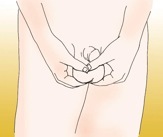-
Playing It Safe


Testicular Self-Exam (TSE)
Cancer of the testicles, the primary male sex glands, is the most common type of cancer in males aged 20 to 35.
To detect signs of testicular cancer, do a testicular self-exam (TSE) as advised by your doctor or health care provider.
Doing a TSE is easy and takes only a few minutes.
-
1.Stand in front of a mirror. Look for any swelling on the skin of the scrotum.
-
2.Examine each testicle with both hands. Place the index and middle fingers underneath the testicle and the thumbs on top. Gently roll one then the other testicle between the thumbs and fingers. One testicle may be larger. This is normal. Examine for any lumps (usually painless and about the size of a pea) on each testicle.
-
3.Find the epididymis (the comma-shaped cord behind the testicle). This may be tender to the touch. Examine it for lumps.
-
4.Examine the vas deferens (the tubelike structure at the back of each testicle) for lumps.
Reasons to Contact Your Health Care Provider
-
•A lump on a testicle, epididymis, or vas deferens.
-
•An enlarged testicle.
-
•A heavy feeling, pain, or discomfort in the testicle or scrotum or a change in the way the testicle feels.
-
•A dull ache in the lower abdomen or the groin.
-
•A sudden collection of fluid in the scrotum.
-
•Enlarged or tender breasts.
These can be signs of cancer or other conditions. When found early, testicular cancer is very curable. This is why a monthly TSE is very important.



Copyright © 2007, American Institute for Preventive Medicine. All rights reserved.



For more information, contact:
The Cancer Information Service | 800.4.CANCER (422.6237) | www.cancer.gov
The Testicular Cancer Resource Center | www.acor.org/TCRC

